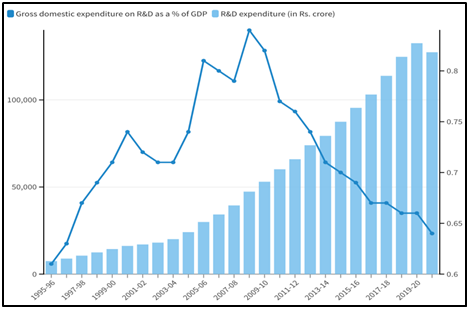What’s in Today’s Article?
- Background (Context of the Article)
- India’s R&D Spending (Statistics, Ways to Improve, Role of Pvt Sector, Sustainable Funding)
Background:
- The 2024 theme for National Science Day, which India celebrates every year on February 28, is “Science for Sustainable Development”.
- Science and technological developments are key drivers of India’s journey towards becoming a developed country by 2047.
- India is committed to making this progress through sustainable means, as evidenced by its commitments under the Paris Agreement.
- The role of science in driving sustainable development doesn’t need emphasis.
- However, any conversation on science is incomplete without setting one key expectation: for science to transform India, it has to be sustainably and consistently funded.
How Much is India Spending on R&D?

- Funding for fundamental research in India is amongst the world’s lowest, particularly for a country with high science and technology ambitions.
- In the recent past, India’s R&D expense has dropped to the current 0.64% of GDP from 0.8% in 2008-2009 and 0.7% in 2017-2018.
- This reduced expenditure is worrying considering government agencies themselves have issued several calls to double this spending.
- The 2013 Science, Technology, and Innovation Policy noted that “Increasing Gross Expenditure on R&D (GERD) to 2% GDP has been a national goal for some time”.
- The 2017-2018 Economic Survey reiterated this in its chapter on science and technology transformation.
- The reasons for the reduction in R&D spending despite the government being cognisant of the need to increase it are not clear.
- However, it may stem from a lack of coordination between government agencies and a need for stronger political will to prioritise R&D expenses.
- Most developed countries spend between 2% and 4% of their respective GDPs on R&D.
- In 2021, member-countries of the Organisation for Economic Co-operation and Development (OECD) on average spent 2.7% of GDP on R&D.
- The U.S. and the U.K. have consistently spent more than 2% of their GDPs on R&D for the past decade.
- So, many experts have called for India to spend at least 1%, but ideally 3%, of its GDP every year until 2047 on R&D for science to have a meaningful impact on development.
How Can India Improve its R&D Spending?
- For India to reach ‘developed nation’ status, it needs to spend more to scale R&D than developed countries spend to maintain that status.
- This is the foundation of the demand to spend at least 3% of the GDP on R&D annually until 2047.
- And beyond the current spending being inadequate, its primary dependence on public money signals an immature financing system and weak domestic market.
- In 2020-2021, private sector industry contributed 36.4% of the GERD whereas the Union government’s share was 43.7%.
- State governments (6.7%), higher education (8.8%), and public sector industry (4.4%) were the other major contributors.
Hesitance of the Private Sector:
- In economically developed countries, a major share – 70% on average – of R&D investment comes from the private sector.
- The hesitancy of private-sector funding may be because of:
- poor capacity to evaluate R&D in India,
- ambiguous regulatory roadmaps that can deter investors,
- lack of clear exit options for investors in sectors such as biotechnology, and
- fears of intellectual property rights theft.
How is the R&D Budget Utilised?
- While the need for India to at least double its R&D investment has been expressed several times, the question of how effectively the allocated money is spent is explored less often.
- The Union Ministry of Science and Technology has consistently under-utilised its budget.
- In 2022-2023, the Department of Biotechnology (DBT), used only 72% of its estimated budget allocation on Centrally Sponsored Schemes/Projects.
- The Department of Science and Technology (DST) used only 61%.
- The Department of Scientific and Industrial Research (DSIR), which receives the lowest allocation for Centrally Sponsored Schemes, spent 69% of its allocation.
Sustainable Funding for R&D is the Way Forward:
- In the latest budget, Finance Minister Nirmala Sitharaman provided many indications that the government would like R&D expenditure to include more contributions from the private sector.
- Against this backdrop, mitigating the under-spending and under-utilisation of funds earmarked for R&D stand out as obvious first steps.
- This in turn requires the political prioritisation of R&D spending and recognition of it as a core, irreplaceable element of India’s growth journey.
- This prioritisation has to happen not only within the concerned Ministries but also at the Ministry of Finance, which disburses the funds.
- Incentives for private investment, including relaxation of foreign direct investments, tax rebates, and clear regulatory roadmaps for products will help build investor confidence.
- Finally, India also needs the bureaucratic capacity to evaluate science projects and, after allocations, monitor utilisation.
- Building such capacity is a prerequisite for India becoming a science power by 2047.









